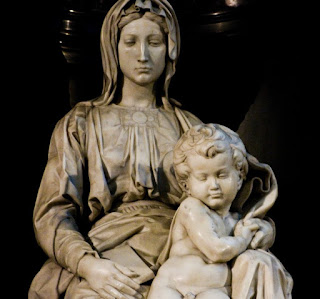OUR LADY OF BRUGES, WHERE A LOCK OF THE VIRGIN MARY'S HAIR IS PRESERVED
 |
| Statue of Our Lady of Bruges by Michelangelo |
Feast Day - March 21
Flanders (1150)
We have a report that, in a shrine in Flanders, dedicated to the Blessed Virgin Mary, a lock of Our Lady’s hair is preserved, which was given by a Syrian bishop, whose name is Mocca. This shrine is dedicated to Mary, because it was she who gave her own blood to her Divine Son, the God made Man.
This shrine also, is likewise said to house the famous relic of the Holy Blood, and this is the center of attraction of all the pilgrimages made to the Shrine. This precious relic was brought from Palestine by Thierry of Alsace on his return from the second crusade. From 1150 this relic has been venerated with great devotion. The annual pilgrimage attended by the nobility in their old-fashioned robes takes place on the Monday following the first Sunday in May. Not only the Flemish nobility take part, but also thousands of pilgrims from all over Christian World.
Every Friday the relic is less solemnly exposed for the veneration of the Faithful.
As at all the Marian shrines, miracles take place through the intercession of the Mother of God.
The present Gothic cathedral of Notre-Dame in Bruges was built in 1225, and is famous for its 400 feet tall brick tower. Inside, however, is where the real treasures are kept. Among those relics already mentioned, there is also a Madonna of Bruges, a marble sculpture of the Blessed Virgin Mary and the Divine Child sculpted by Michelangelo.
The features of the Blessed Virgin depicted in the Madonna of Bruges are very similar in appearance to the famous Pieta, which Michelangelo was said to have completed just prior to this sculpture. It is the only one of his works that left Italy during Michelangelo’s lifetime, and was purchased and brought to Bruges by a wealthy merchant.
In 1794 the inhabitants of Bruges were forced by the French Revolutionaries to ship the Madonna of Bruges to Paris. It was fortunate that the statue was not destroyed, as so many Catholic works of art were destroyed during the French Revolution. The statue did not remain long in Paris, as it was returned to Bruges after the defeat of Emperor Napoleon. It was taken again in 1944 when the German’s retreated from Belgium, but it was discovered two years later in Germany and returned once again to Bruges.



Post a Comment